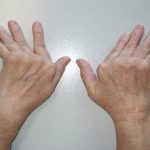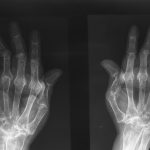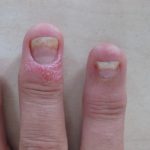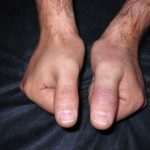Any inflammation at joint level is called arthritis. It is characterized by the presence of pain, redness, local heat and limitation of joint functional capacity. Arthritis produces pain with “inflammatory” characteristics, that is to say, morning predominance, which usually improves with movement and does not subside with rest.
The differential diagnosis between one type and another is based on a correct history and physical examination, as well as certain imaging tests (X-rays, ultrasounds) and analytical tests.
Rheumatoid Arthritis
It is a disease in which the joints become inflamed, causing pain, deformity and difficulty in movement, although it can also affect other parts of the body. It is a chronic disease, with a low frequency of spontaneous healing, although with adequate treatment a good control of the disease is achieved in most cases.
The discomfort and limitations caused by rheumatoid arthritis vary greatly between patients, so that no two patients are alike. Rheumatoid arthritis is one of more than 100 existing rheumatic diseases, with a specific prognosis and treatment, so the diagnosis must be accurate (usually made or confirmed by a rheumatologist).
Rheumatoid arthritis is common, since in our environment one in every 200 people suffer from it (200,000 affected in Spain). It is more common in women, but it also affects men. It is not a disease of old age and although it can appear in the elderly, it occurs more frequently between the ages of 45 and 55. Likewise, a very similar form of arthritis can affect children.
Inflammation of the joints causes pain and swelling. Joint pain is the most frequent symptom and joint swelling can be more or less visible to the patient. The most commonly inflamed joints are the wrists, finger and toe joints, elbows, shoulders, hips, knees and ankles. In addition to the pain and swelling, in the mornings there may be difficulty in starting movements (morning stiffness) of varying duration, and which may even last for several hours.
Persistent inflammation can eventually damage the surrounding bones, ligaments and tendons. The consequence will be the progressive deformity of the joints and the loss and reduction of joint mobility, which can lead the patient to a certain degree of disability to carry out some tasks of daily life.
Rheumatoid arthritis does not currently have a curative treatment, which does not mean that there is no treatment. What’s more, new medicines are appearing that make it possible to control the disease in an increasingly high percentage of patients. The collaboration between the patient and the doctor is essential for the control of this disease.
- Deformitat d’articulacions metacarpofalàngiques “a cop de vent” en pacient amb artritis reumatoide de llarga evolució.
- Destrucció articular severa en carps i articulacions metacarpofalàngiques i interfalàngiques de les dues mans en pacient amb artritis reumatoide de llarga evolució.
Psoriatic Arthritis
It is a disease of the joints that occurs in some patients (approximately 10%) who suffer from psoriasis on the skin, which gives it peculiar characteristics in terms of evolution and prognosis. The joint injury is inflammatory, that is to say, with pain, swelling, heat, and difficulty moving the affected joint, and the long possibility of deformation. The severity of arthritis is unrelated to the extent of skin damage. It is a chronic disease, which evolves irregularly throughout life, with periods of inactivity and periods of inflammation and pain.
It is a common disease since if we consider that psoriasis affects 2% of the population and arthritis affects 10% of them, in Spain, out of a population of about 40 million, there would be 80,000 people with psoriatic arthritis . The onset of psoriatic arthritis usually occurs between the ages of 30 and 50, and can affect people of any age and sex, even children.
Psoriatic arthritis starts slowly. Psoriasis usually appears years before the joint involvement and only 15% of arthritic patients present the joint lesion before the skin or nail lesion.
For a correct diagnosis, skin or nail lesions must be confirmed as psoriatic. First, demonstrating that psoriasis is present, then demonstrating that arthritis is present, and finally confirming that the clinical and radiological features correspond to psoriatic arthritis.
Psoriatic arthritis currently has no curative treatment, which does not mean that there is no treatment. What’s more, new medicines are appearing that make it possible to control the disease in an increasingly high percentage of patients.
- Els pacients amb psoriasi en ungles és més freqüent que desenvolupin una artritis psoriàsica
- La dactilitis (o “dit en salsitxa”) pot ser una manifestació clínica comuna en aquesta malaltia.




